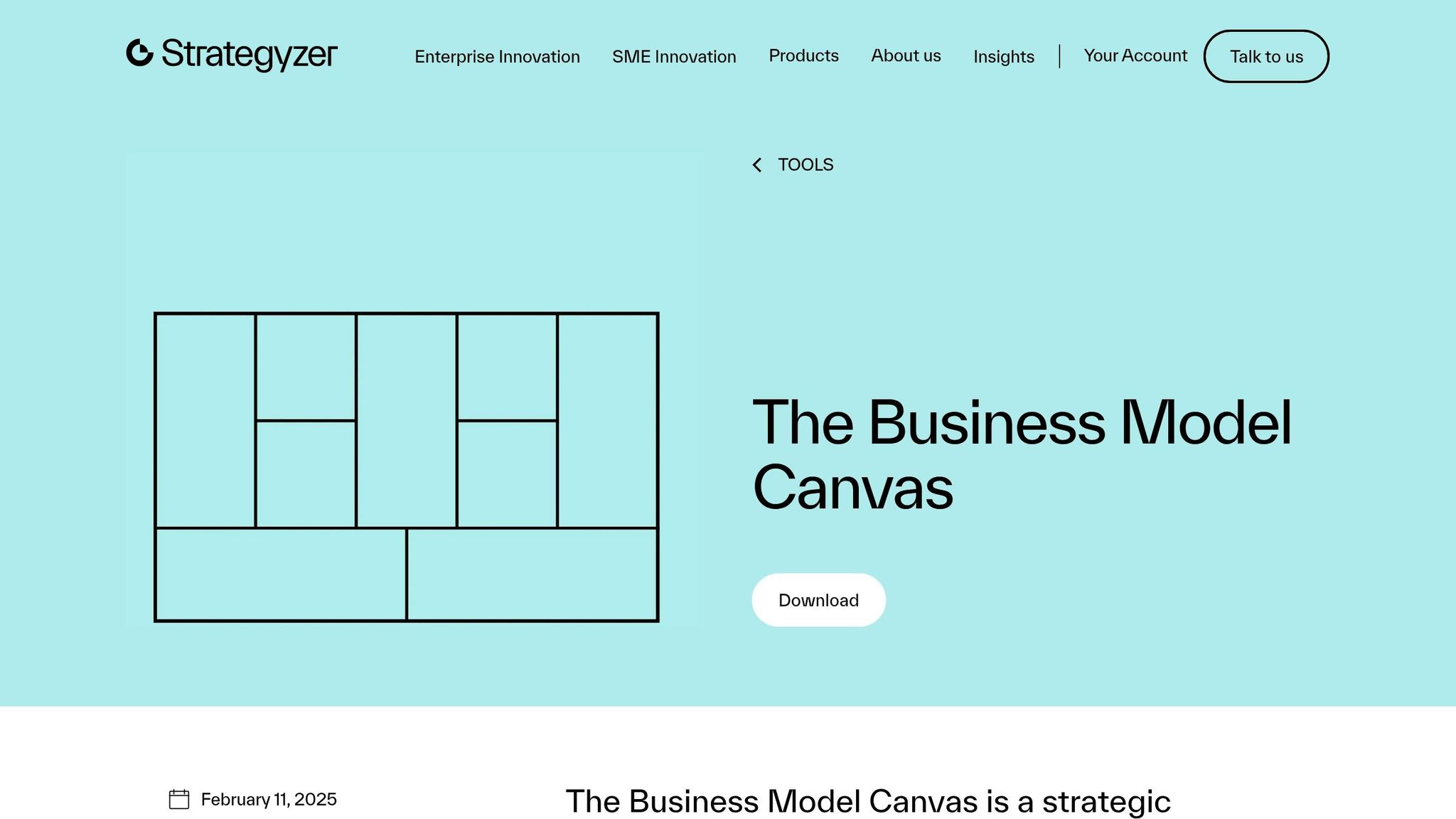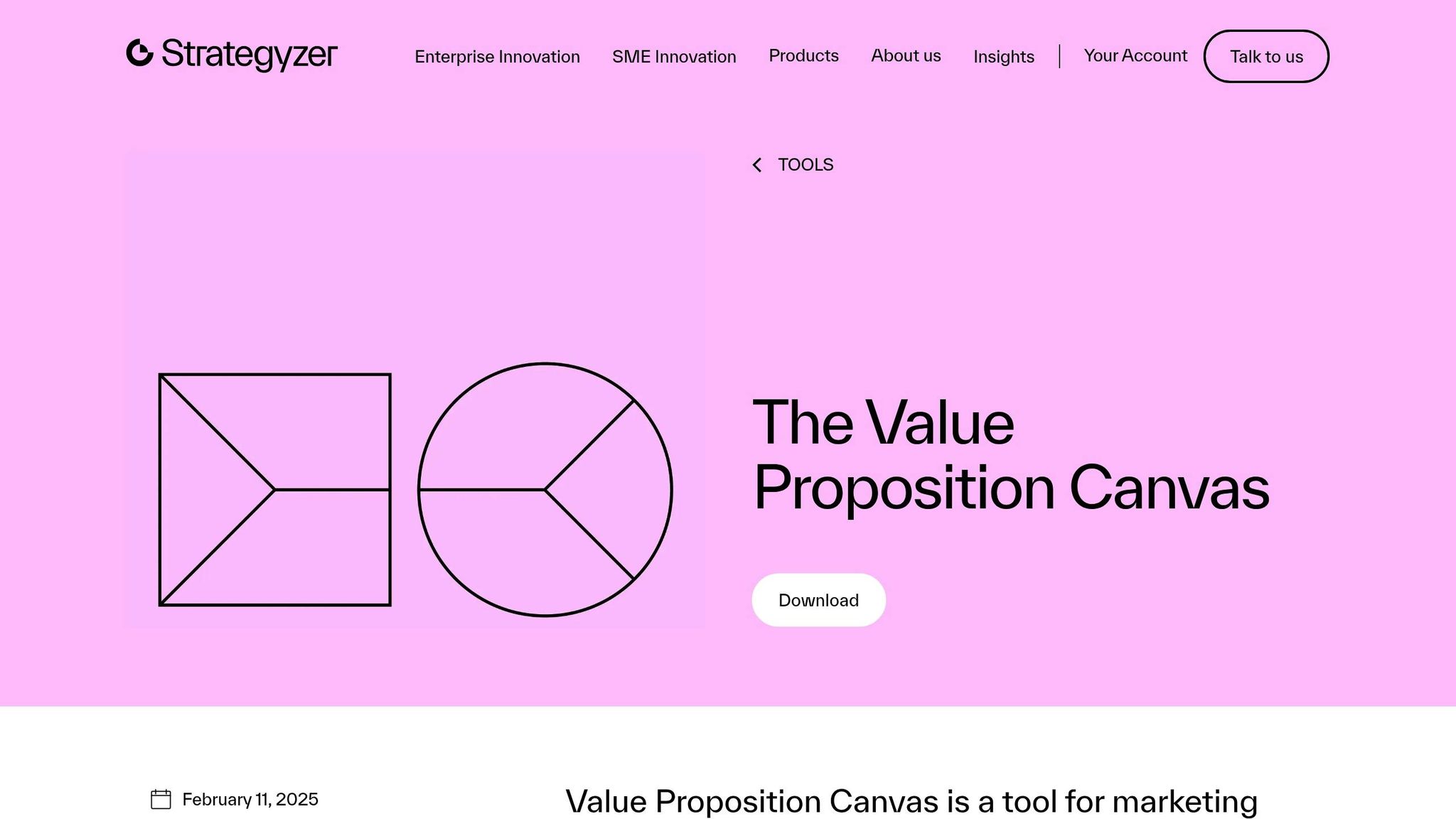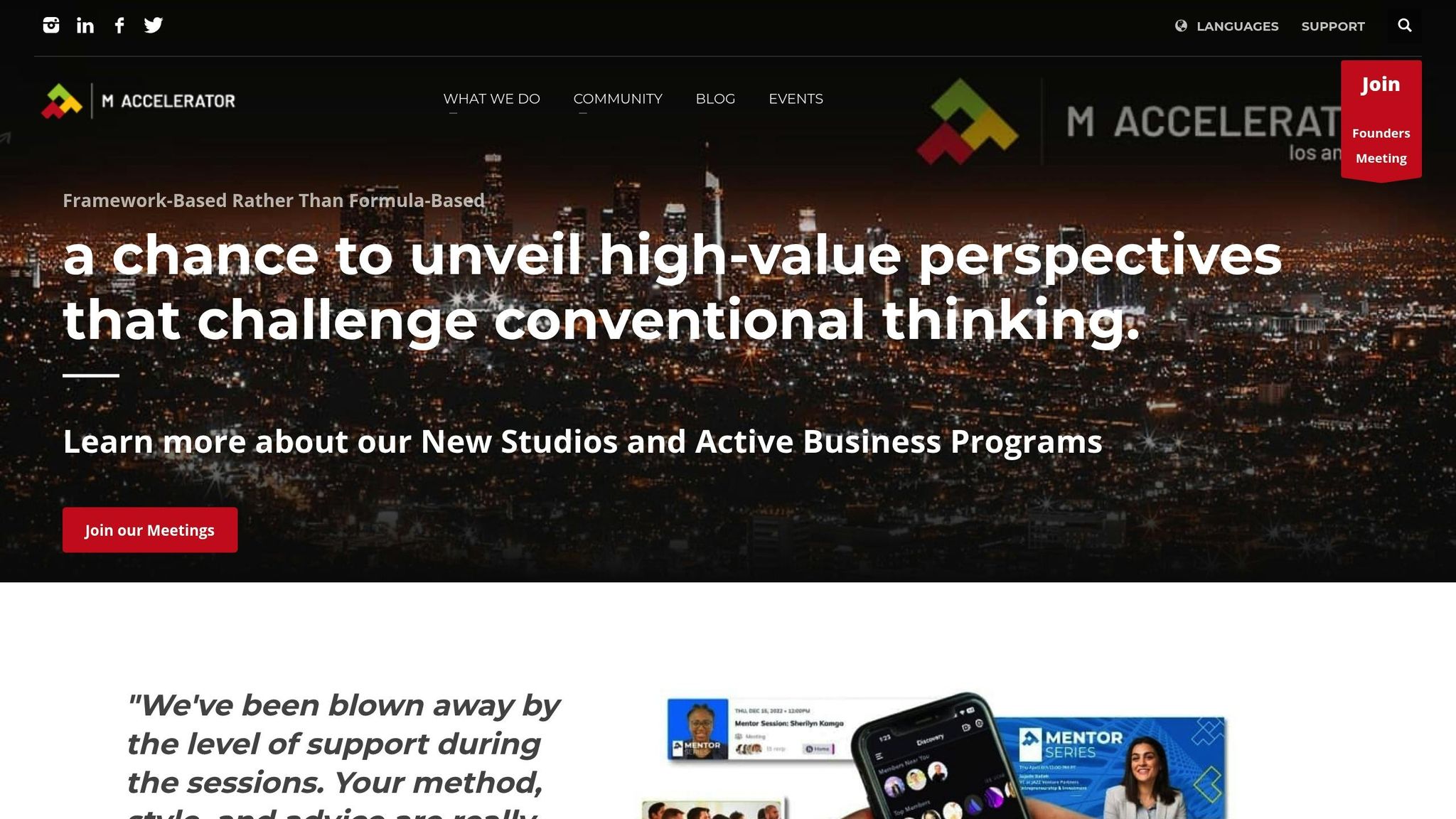Businesses thrive when their value propositions align with their business models. A value proposition explains how you solve customer problems, while a business model ensures you deliver on that promise effectively. Here’s how to connect the two:
- Use the Business Model Canvas (BMC): Break down your business into key components like customer segments, channels, revenue streams, and more.
- Leverage the Value Proposition Canvas (VPC): Focus on customer needs, pains, and gains, and align them with your products, pain relievers, and gain creators.
- Bridge the BMC and VPC: Match customer profiles with segments, align resources with value delivery, and ensure financial sustainability.
4 Steps to Get Started:
- Identify Customer Needs: Understand their tasks, challenges, and goals using the VPC.
- Link Value to Operations: Connect your value propositions to resources, channels, and revenue streams in the BMC.
- Test and Improve: Experiment with market feedback and refine your approach.
- Adapt as You Grow: Tailor your strategy at each growth stage, from ideation to scaling.
By consistently refining your approach, you can ensure your business delivers value while staying profitable.
Value Propositions and the Business Model Canvas

Key Tools: Business Model Canvas and Value Proposition Canvas

The Business Model Canvas (BMC) and Value Proposition Canvas (VPC) are essential tools for outlining how your business provides value to customers while staying profitable. Together, they offer a clear framework to analyze and refine your business strategy.
Business Model Canvas Overview
The Business Model Canvas breaks your business down into nine essential components:
- Value Propositions: The products or services that solve problems or meet customer needs.
- Customer Segments: Specific groups of people or organizations your business serves.
- Channels: The ways you deliver your value propositions to customers.
- Customer Relationships: How you build and maintain connections with your customers.
- Revenue Streams: The income sources for your business.
- Key Resources: The assets needed to operate and deliver value.
- Key Activities: The main tasks your business must perform to function.
- Key Partners: External organizations or individuals that help your business succeed.
- Cost Structure: The major expenses involved in running your business.
This canvas provides a snapshot of your entire business structure.
Value Proposition Canvas Breakdown
The Value Proposition Canvas focuses on aligning your offerings with customer needs. It has two main sections:
Customer Profile
- Jobs: The tasks or goals your customers are trying to achieve.
- Pains: The obstacles or frustrations they face.
- Gains: The outcomes or benefits they hope to achieve.
Value Map
- Products & Services: What your business offers.
- Pain Relievers: How your offerings address customer challenges.
- Gain Creators: How your offerings create positive outcomes for customers.
Bridging the BMC and VPC
Using the BMC and VPC together ensures your strategy is both cohesive and actionable. Here’s how they connect:
- Customer Alignment
Match the customer segments in the BMC with the customer profiles in the VPC to ensure you’re targeting the right audience. - Value Integration
Cross-check the value propositions in both canvases to confirm your solutions meet customer expectations. - Resource and Activity Matching
Align the resources and activities in the BMC with the pain relievers and gain creators in the VPC for efficient delivery of value.
4 Steps to Map Value Propositions to Business Models
Step 1: Identify Customer Needs
Start by using the Value Proposition Canvas to understand your customers. Focus on their tasks, challenges, and desired outcomes. This step ensures you’re addressing real problems and opportunities in the market.
"We clearly identify all the business factors and build a map that helps a founder make smart decisions, gain a clear direction, and connect their business to the right market (yes, we focus on GTM)."
Break down what your customers are trying to achieve, the obstacles they face, and what they hope to gain.
Step 2: Link Value Propositions to Business Components
Once you’ve identified customer needs, align your value propositions with key parts of your business model. This ensures every piece of your operations supports delivering on your promises. Make clear connections between:
- Value propositions and key resources: What tools or assets are essential to deliver value?
- Customer segments and distribution channels: How do you effectively reach your audience?
- Revenue streams and cost structure: How does delivering value translate into financial sustainability?
| Business Component | Connection |
|---|---|
| Key Resources | Tools and assets needed to deliver value |
| Distribution Channels | Methods to reach target customers |
| Revenue Streams & Cost Structure | How value creation generates income and manages costs |
By linking these components, you’re setting up a system that supports your value delivery.
Step 3: Test and Improve
Use M Accelerator’s framework to test and refine your value propositions. This process includes:
- Market Testing
Experiment with digital campaigns, A/B tests, or pilot programs to gauge customer interest. - Message Refinement
Adjust your messaging based on customer feedback and ensure your value statements are clear and compelling. - Performance Tracking
Monitor engagement metrics and customer responses to fine-tune your approach.
"After this startup program, I have a lot more clarity in which direction we should take, which tools we can use, and how we can go about it… So often, we tend to design solutions that outcompete your competitors in all aspects instead of focusing on the factor that has the most impact." – Melissa Kariuki, Founder at Whip Music Africa, Product Manager at Google
sbb-itb-32a2de3
Tips for Better Value Proposition Mapping
Focusing on Key Customer Segments
To make your value proposition mapping more effective, zero in on the customer segments where your solution delivers the greatest impact. Instead of trying to appeal to everyone, focus your efforts on the groups that benefit the most.
Key factors to consider:
- Pain point intensity: Target segments facing the most pressing challenges.
- Market readiness: Choose groups that are ready to embrace your solution.
- Economic viability: Make sure the segment aligns with your business model and can sustain it.
Mapping at Different Growth Stages
Your approach to value proposition mapping should evolve as your business grows. Each stage of growth demands a tailored strategy to keep your value propositions relevant and aligned with customer expectations.
| Growth Stage | Mapping Focus | Key Considerations |
|---|---|---|
| Ideation | Problem-Solution Fit | Test assumptions about your customers’ core needs. |
| Seed | Product-Market Fit | Experiment with value propositions in the market. |
| Growth | Market Expansion | Adjust propositions for new audiences and markets. |
| Scale-up | Value Optimization | Refine based on feedback and market insights. |
These stage-specific strategies help you refine your approach, ensuring your value propositions remain aligned with customer needs and market dynamics. By continuously iterating, you can adapt to changes and fine-tune your offerings.
Value proposition mapping isn’t a one-and-done task – it’s an ongoing process. Regular updates and adjustments are essential to staying relevant and impactful. Stay flexible, but always prioritize the core value drivers that resonate most with your audience.
Next, learn how M Accelerator can help integrate these strategies into your business model.
M Accelerator‘s Approach to Value Proposition Mapping

M Accelerator refines the process of delivering value by using a customized and integrated framework that builds on proven mapping strategies.
M Accelerator’s Value Proposition Support
M Accelerator uses a framework designed to align value propositions with business models. Instead of relying on rigid formulas, this approach prioritizes creating value that resonates with customers.
The framework is structured around three main dimensions:
| Dimension | Focus Areas | Outcomes |
|---|---|---|
| Strategic Planning | Validating business models and go-to-market strategies | Clear direction and alignment with the market |
| Value Integration | Ensuring product-market fit and addressing customer needs | Effective delivery of value |
| Implementation | Marketing, presentation, and execution | Practical application and clear communication |
By building on earlier mapping techniques, this framework ensures that every operational element contributes to tangible market success. It helps founders zero in on the factors that make the biggest difference for their target customer segments.
Success Examples and Applications
The effectiveness of M Accelerator’s framework is evident across various industries and stages of business development:
Fertility Circle (2021)
After participating in the MA Startup Program, Fertility Circle successfully raised $800,000. CEO Abi Hannah praised the program’s support:
"We’ve been blown away by the level of support during the sessions. Your method, style, and advice are really wonderful."
– Abi Hannah, CEO at Fertility Circle
PinChef (2021)
PinChef refined its value proposition by developing a well-rounded pitch deck that tackled the problem from multiple angles.
Tora Tora Travel (2018)
Starting as an idea, Tora Tora Travel grew into a 12-member team, thanks to the program’s strategic guidance.
M Accelerator tailors its approach to different stages of business development:
- Founders Studio: Focused on achieving product-market fit.
- Startup Program: Designed to help seed-stage companies validate their business models.
- Scale-Up Coaching: Supports growing businesses in expanding their market reach.
This structured method ensures that founders can map their value propositions effectively while staying strategically focused as they scale. The next section will explore additional strategic initiatives built on this foundation.
Conclusion
To wrap things up, let’s focus on a few key principles that tie everything together.
Matching value propositions to business models isn’t a one-size-fits-all process. Instead, think of it as a flexible approach that evolves as your business grows.
Tools like the Business Model Canvas and Value Proposition Canvas can help ensure your value delivery stays in sync with your operations, even as you scale.
For growth that lasts, keep these priorities in mind:
- Consistent testing: Regularly review and adjust your model based on market feedback.
- Clear direction: Stay focused on your goals while staying open to market shifts.
- Adaptable methods: Allow your approach to grow and change alongside your business.
These principles provide a solid foundation for connecting value propositions with business models effectively.
FAQs
How can I use the Business Model Canvas and Value Proposition Canvas together to align my business strategy?
The Business Model Canvas and Value Proposition Canvas are powerful tools that work seamlessly together to create a cohesive business strategy. Start by using the Value Proposition Canvas to define how your product or service solves customer problems and meets their needs. Then, map these insights onto the Business Model Canvas to ensure your value propositions align with key elements like customer segments, revenue streams, and delivery channels.
By integrating these frameworks, you can identify gaps, refine your approach, and ensure that every aspect of your business model supports delivering value to your customers. This alignment helps build a strong foundation for growth and sustainability in your business.
What challenges do businesses face when aligning value propositions with their business models, and how can they address them?
Aligning value propositions with business models can be challenging for many businesses. Common obstacles include misunderstanding customer needs, lack of clarity in value delivery, and difficulty adapting to market changes. These challenges can result in a disconnect between what the business offers and what customers truly value.
To overcome these issues, businesses can:
- Use tools like the Business Model Canvas to map out how their value propositions align with customer segments, revenue streams, and key activities.
- Continuously gather customer feedback to refine their offerings and ensure they address real needs.
- Test and iterate their business model to adapt to changing market conditions and stay relevant.
By taking a structured approach and focusing on customer-driven insights, businesses can create stronger alignment and drive sustainable growth.
How can businesses adjust their value proposition mapping as they grow, from ideation to scaling?
As your business evolves from ideation to scaling, your value proposition mapping should adapt to reflect changing customer needs, market dynamics, and growth objectives. In the early ideation stage, focus on identifying the core problem your product or service solves and defining the target audience. Use tools like the Business Model Canvas to align your value proposition with customer segments and key activities.
As you transition to growth and scaling, refine your value proposition based on customer feedback and market data. Prioritize features or services that deliver the most value, and ensure your business model supports scalability. This iterative approach helps maintain alignment between your offerings and the evolving demands of your customers.
For personalized guidance on these processes, programs like those offered by M Accelerator can provide tailored coaching and strategic frameworks to support your entrepreneurial journey.